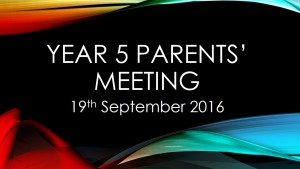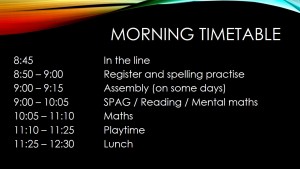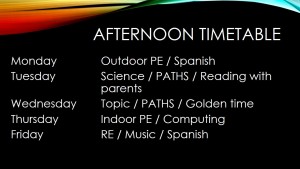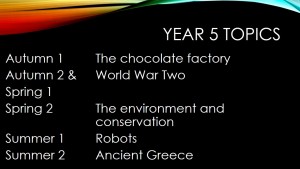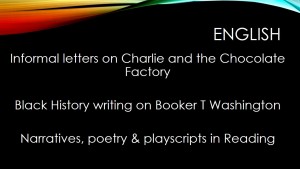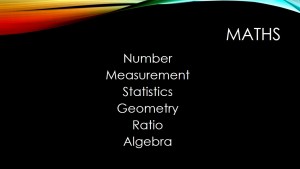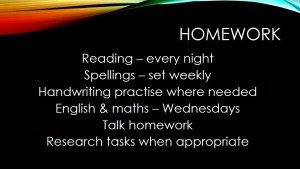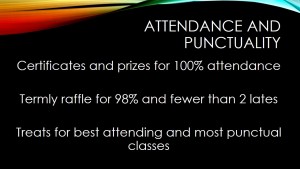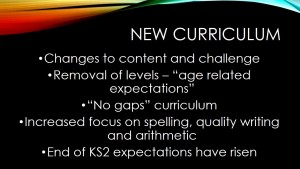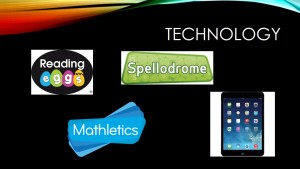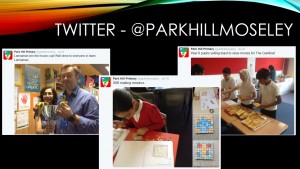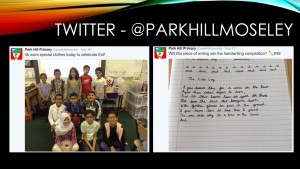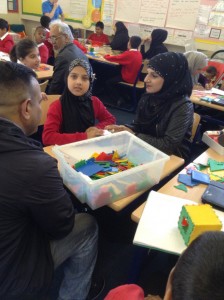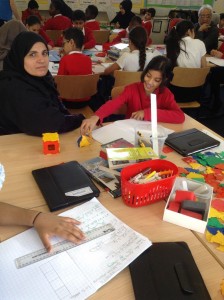Year Five 2016-17
Year 5 visited the Think Tank on Friday 9th June
**************************************************************************************************************
Dear Parents,
We hope you have had a restful and enjoyable holiday and would like to wish those who celebrated it a very Happy Easter! This half term we are embarking upon an all new topic about Robots and Programming, in which we will learn all about how robots work and their uses and applications in society. This will also include building our very own robots using some exciting new Lego robotics kits, working up to a project in the final week in which pupils will design their own robotic gadget! We will also be looking at how robots and computer sequences can be used to produce music.
In English lessons, we are précising a short text, before moving on to writing non-chronological reports on our topic theme of Robots.
Maths this term will see us continuing with written and mental calculation methods, place value, shape and statistics. Pupils have been issued with usernames and passwords for the Mathletics website, so be sure to ask your child to show you how it works! Please work with your children to ensure they are fully confident with all times table facts up to 12 x 12.
Our computing unit goes hand in hand with the robotics topic, and pupils will learn how to give a sequence of instructions to their Lego robots, and to debug and find problems with their programs.
In PE lessons, we will be playing cricket in our games session on Mondays, developing skills in bowling, batting and fielding. On Thursdays, we will be starting athletics, which will include running, jumping and throwing. Please help your child to remember the appropriate P.E kit on these days. Correct PE kit is: plain white t-shirt or long sleeved top, plain black shorts/leggings/tracksuit bottoms, trainers.
Our new science topic is Friction and Air Resistance, in which we will be investigating forces and air resistance and continuing to understand the scientific method.
Our RE lessons this term will see us considering temperament, self-control and meditation from the point of view of a wide range of world beliefs.
We will be continuing with the PATHS programme to develop emotional, behavioural and problem solving skills and we will be continuing to learn Spanish.
We look forward to your continuing support this half term.
Mr A Game, Miss A Brown, Miss S Begum, Mrs S Singh and Ms J Smith
The Year 5 Team
*********************************************************************************************
Dear Parents,
Having enjoyed a relaxing and restful holiday, we will be continuing our topic on The Second World War.
In the first week, during English lessons, we will be learning how to stay safe online and produce a leaflet on e-safety. We will be starting a narrative based on our Second World War topic.
Maths this term will see us continuing with written and mental calculation methods, place value, shape and statistics. Pupils have been issued with usernames and passwords for the Mathletics website, so be sure to ask your child to show you how it works!
In computing, our unit is We are Artists, and we are going to be looking at vector and turtle graphics, inspired by the works of Escher, Riley and some traditional Islamic artists.
In PE lessons, we will be moving onto dance and developing group and individual dance sequences. We will develop our tactics for invasion games through netball and tag rugby. Outdoor PE takes place on Mondays and indoor PE is on Thursdays. Please help your child to remember the appropriate P.E kit on these days. Correct PE kit is: plain white t-shirt or long sleeved top, plain black shorts/leggings/tracksuit bottoms, trainers (outdoor) or pumps (indoor).
Our science topic is Life Cycles, where we will be exploring the life cycles of humans with a particular focus on the life cycles of chickens and birds.
Journey into Space is our theme for music, and the children will learn about sound sources in the environment and how technology is used to produce sounds.
In our RE lessons, we will be learning about Being Open, Honest and Truthful from the point of view of several different faiths.
We will be continuing with the PATHS programme to develop emotional, behavioural and problem solving skills and we will be continuing to learn Spanish.
We look forward to your continuing support this half term.
Regards.
Mr A Game, Miss A Brown, Miss S Begum, Miss R Khatun, Mrs S Singh and Mrs J Smith.
The Year 5 Team
*********************************************
Year 5 visit to Safeside which is the headquarters of the West Midlands Fire Service on Thursday 1st December
Year 5 enjoyed learning about thinking and acting safely and looking after our community & environment
**********************************************************************************************
As in previous years, we will be running workshops – for Parents only – to learn about how subjects are taught in school.
Year 5 and 6 Maths Workshop – Wednesday 16th November from 9am to 10am
ARITHMETIC – QUESTION TYPE, PRESENTATION, REHEARSAL, PROFICEINCY & SPEED
- KS2 SATS ARITHMETIC PAPER is 30 minutes long with 36 questions worth 40 marks.
- Questions are only presented as equations.
| STRAND/type | CALCUALTION DESCRIPTION | EXAMPLES |
| 1. ADDITION
· Simple place value addition |
No written calculation required – recognition of increase of a specific place value | 476 + 100 = |
| · Simple unit & tenths addition | No written calculation required – as above – recognition that addition will not impact other place values (carrying) | 6.2 + 0.6 = |
| · Simple unit, tenths & hundredths addition | No written calculation required – recognition of the fact that there are no values in the second number to add to the first, also that the ‘5’ is in the hundredths place | 2.5 + 0.05 = |
| · 4 digit number & 3 digit number addition | Written calculation – place values must be aligned correctly if using column method as both numbers have different values, ‘carrying’ must be checked – number line method could be used | 1,063 + 487 = 1063
487
|
| · 4 digit number & 4 digit number addition | Written calculation – largest number at top – place values must be aligned correctly if using column method as both numbers have different values, ‘carrying’ must be checked – number line method could be used | 5,356 + 8,253 = 8253
5356 |
| · Addition of fractions with common denominator | Numerators add to give total of denominator | + = |
| · Addition of fractions with an uncommon denominator | Fractions where denominators are uncommon must be converted so that denominators are common. This is done by finding a common denominator. When denominators are converted, numerators must be converted by the same scales. Only then can the fractions’ numerators be added. | + =
+ = |
| · Addition of mixed numbers with fractions with uncommon denominators | Fractions can be added in isolation from whole numbers however their denominators are not common and so must be converted before subtraction as must their numerators. | 2 + = |
| 2. SUBTRACTION
· Subtracting ‘9’ |
No written calculation required – identify the ten’s digit and reduce it by one ten then add one unit to adjust the subtraction of the extra unit – this is called ‘special case 9’ subtraction | 463 − 9 =
463 – 10 + 1 = |
| · Subtraction of round hundred from a five digit number | No written calculation required – identify that 500 is half of a thousand, identify the thousand below and add on 500 | 40,000 − 500 = |
| · Subtraction of fractions with a common denominator | Subtract the numerator of the second fraction from the first – no need for conversion of denominators because they are common | – = |
| · Subtraction of a unit, tenth and hundredth from a whole integer | Can be done mentally, by subtracting unit, then decimal; can be done using ‘shopkeeper’s change’ number line method or for pupils who are not secure with their place value, a column subtraction incorporating a decimal point and zeroes as place holders for the whole integer – draw back for this method is ‘messy’ decomposition | 14 − 6.01 = |
| · Subtraction of mixed values | As above – second and third methods | 13.4 − 6.98 = |
| · Decomposition columnar subtraction of ten thousand from hundred thousand | Written subtraction method lining up place values in columns and subtracting place value by place value. Where a digit in a place value of the greater number cannot subtract a larger digit value of the smaller number, the next place value may be decomposed to create a larger value. | 214,487 – 45,195 =
214,487 45,195 |
| · Subtraction of fractions with uncommon denominators | Fractions where denominators are uncommon must be converted so that denominators are common. This is done by finding a common multiple of both denominators. When denominators are converted, numerators must be converted by the same scales. Only then can the fractions’ numerators be subtracted. | – = |
| · Subtraction of mixed numbers with uncommon denominators | Fractions can be subtracted in isolation from whole numbers however their denominators are not common and so must be converted before subtraction as must their numerators. | 2 – = |
| 3. MULTIPLICATION
· Multiplication by 2/double |
No written calculation required – number can easily be doubled as none of the place values will affect the others | 132 × 2 = |
| · Multiplication of two digit number by one digit number – out of tables range | Short written compact method or partitioning | 24 × 3 =
20 x 3 + 4 x 3 =
24 x 3 |
| · Use of commutative law within multiplication and associative law | Numbers in multiplication can be rearranged in any way (commutativity). They can also be calculated in a different grouping (associativity). | 5 × 3 × 4 =
5 x 4 x 3 = 20 x 3 = |
| · Use of place value to multiply | No written calculation required – recognition of movement of digits two places to the left to x by 100 | 4.16 × 100 = |
| · Short written compact method to multiply mixed values by single digit | Short written compact method – multiply each value from the right to left | 1.32 × 6 =
1.32 x 6 |
| · Long multiplication written method | Multi-step multiplication – first by unit then by ten – then addition of both products in second phase
– 2 marks |
76
x 23 |
| · Multiplying fractions | Multiply the numerator by numerator and denominator by the denominator | x = |
| · Multiplying fractions by a whole number | Make the whole number a fraction numerator over one – or imagine (in this case 5 sets of one sixth) | x 5 =
x = |
| 4. DIVISION
· Recall of a known division fact |
No written calculation required – recall of division fact or inverse x fact | 54 ÷ 6 = |
| · Identify related division fact | No written calculation required – identification of related division fact being ten times bigger e.g.
144 ÷ 12 = 12; so 1440 ÷ 12 = 120 |
1,440 ÷ 12 = |
| · Short compact method of division – single divisor | Bus shelter method – address each digit left to right – carrying where remainders for division of each place value | 7,505 ÷ 5 =
_______ 5I 7 5 0 5 |
| · Division of a related three digit fact by a single digit divisor | No written calculation required – in this case, the dividend (270) is a related fact of the divisor (9) and so it should be recognised as 27 ÷ 9 = 3; however, as 270 is ten times larger than 27 and the divisor has stayed the same, the answer must be ten times greater than in 27 ÷ 9 | 270 ÷ 9 = |
| · Long division ‘chunking’ method | Subtract ‘chunks’ from the dividend in multiples of divisor until left with zero or a remainder which cannot be divided – use knowledge of place value – doubling – quadrupling etc… | ________
1 3 I 3 0 1 6 |
| · Division of fractions | When dividing fractions, simply ‘flip’ the second fraction and multiply the result | ÷
x = |
| · Division of fractions by a whole number | Simply multiply the bottom number by the whole number and use the numerator as the numerator in the answer | ÷ 5 = |
| 5. FRACTIONS, DECIMALS, PERCENTAGES (FDP)
· Finding a fraction of a number |
Divide number by denominator and multiply the answer by the numerator | x 24 = or of 18 = |
| · Finding a percentage | Divide value by 10 to find 10% then scale up or down to find correct %. E.g. in this example, 56 divides by 10 to find 10 % then multiply answer by 2 (double) to find 20% | 20 % x 56
or 20% of 56 |
| 6. Other
· Squaring |
Squaring – numbers multiply by themselves | 7²
7 x 7 = |
| · Order of operations
BODMAS Brackets, order, division, multiplication, addition, subtraction |
In multi-step or multi-operation calculations, if there are brackets, do the operations within them before any others. If there are no brackets, division or multiplication must be done (in order written) before subtraction or addition | 20 − 4 × 2 =
20 – (4 x 2)= 20 – 8 = |
********************************************************************************************
Dear Parents,
After enjoying a tasty start to Year 5 with our Chocolate Factory topic, we have moved on to the topic The Second World War and Moseley. Throughout the half-term, we will learn about how the war impacted on our local community and in Britain as a whole, looking in particular at the experience of children. This will include a workshop delivered by the stupendous Professor McGinty!
In English lessons, we will be reading The Diary of Adolphus Tips by Michael Morpurgo. This will inspire us to write descriptive pieces from the point of view of somebody living through the Blitz air raids. We shall also be visiting West Midlands Fire Service Safeside, to learn about conducting ourselves safely; the children will then produce leaflets about personal safety, to their own design.
There is no doubt that children who read at home increase their ability to read fluently and with increased understanding and so we are keen to see children bringing completed reading diaries to school – there are prizes for those who make 10 and 20 comments in their reading diaries! Reading Eggs is also something children can access at home.
Maths this term will see us learning about written multiplication, shapes and measures, division and fractions. Pupils have been issued with usernames and passwords for the Mathletics website, so be sure to ask your child to show you how it works!
In computing, our unit is We are Crytographers, and we are going to be looking at secret communications, which fits in well with our Second World War topic. This will include studying semaphore, Morse code and discussing what makes a good password.
In PE lessons, pupils will continue to develop gymnastic skills and developing their own sequences. Pupils will also develop their tactics for invasion games through a new sport: handball. Outdoor PE takes place on Wednesdays and indoor PE is on Thursdays. Please help your child to remember the appropriate P.E kit on these days. Correct PE kit is: plain white t-shirt or long sleeved top, plain black shorts/leggings/tracksuit bottoms, trainers (outdoor) or pumps (indoor).
Our science topic is Properties of Materials and we will be investigating which materials are best for keeping warm; perfect as the weather gets colder!
Exploring Rounds is our theme for music, and the children will learn about playing and singing in rounds, by introducing different parts at different times in the music.
In our RE lessons, we will be learning about Being Loyal and Steadfast and exploring how different faiths see hope for the future.
We will be continuing with the PATHS programme to develop emotional, behavioural and problem solving skills and learning further words and phrases in Spanish.
We look forward to your continuing support this half term.
Mr A Game, Miss Begum, Miss Brown, Mrs Singh, Miss Khatun and Mrs Smith
The Year 5 Team
******************************************************************
5G Maths Inspire Workshop – nets of a cube challenge
5G Maths Inspire workshop – thank you parents for a fun session
![DB3vKF5U0AAOsOi[1]](http://176.32.230.249/parkhill.bham.sch.uk/wp-content/uploads/2017/06/DB3vKF5U0AAOsOi1-300x225.jpg)
![DB3vKNcVYAAHHWi[1]](http://176.32.230.249/parkhill.bham.sch.uk/wp-content/uploads/2017/06/DB3vKNcVYAAHHWi1-225x300.jpg)

